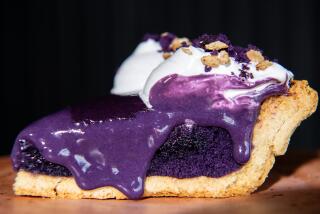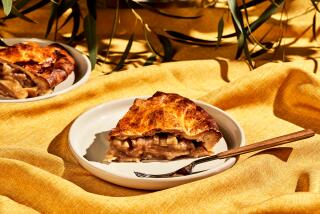Firming Up That Soggy Pie Crust
- Share via
Question: Can you tell me how to prevent a soggy bottom pie crust?
Answer: The following suggestions are adapted from “Secrets of Better Cooking” (Reader’s Digest, 1979):
--If filling the unbaked crust with a wet filling such as custard, first set the crust. Pierce the crust all over. Brush the inside with one egg white lightly beaten with one teaspoon of cold water. Chill for 30 minutes, then bake at 450 degrees five minutes. Allow the crust to cool to room temperature, pour in the filling and then bake according to the recipe requirements.
--When baking a single crust before filling, pierce the crust, brush with one egg white lightly beaten with one teaspoon of cold water and chill one hour. Then bake and cool before adding the filling.
--Never pour a hot filling into a hot or cold pie shell. Both must be cooled.
--For a pie filled with fruit, it helps to coat the bottom crust first with a mixture of one teaspoon flour and one teaspoon sugar. After the pie is filled, bake it at 425 degrees 15 to 20 minutes, then reduce the heat to the recipe specification to finish the baking.
In general, sear all wet pies by baking at 425 degrees 15 minutes. Then reduce heat to 350 degrees and watch to avoid overcooking.
--Bake an unfilled pie shell quickly in the middle of an upper shelf of the oven, but bake a double-crust pie on a lower shelf where the bottom crust will set faster.
Also, the Williams-Sonoma holiday 1989 catalogue for cooks offers a perforated pie pan with “air holes that allow moisture to escape and heat to enter, producing a far crisper crust.” Two of the nine-inch pans may be ordered for $6 from Williams-Sonoma, Mail Order Department, P.O. Box 7456, San Francisco, Calif. 94120-7456, or they may be purchased at Williams-Sonoma stores throughout the Southland.
Q: Do cardamom seeds need to be kept in the refrigerator?
A: No, according to “Keeping Food Fresh--How to Choose and Store Everything You Eat” (Harper & Row, 1989: $10.95). Author Janet Bailey advises:
“Dried herbs and spices lose the strength and character of their essential oils when exposed to heat, light and air. They can be stored at room temperature, but keep them away from the stove, dishwasher, refrigerator, toaster and other appliance that gives off heat.
“Certain spices suffer more than others from high heat. During the summer months you should consider keeping cayenne, paprika, chili powder and red pepper in the refrigerator. Poppy seeds and sesame seeds are rich in oil--they get rancid within several months unless they are stored properly. They keep best in the refrigerator.
“The bottles and tins most herbs and spices come in are perfect storage containers, but the tins have a slight edge because they are lightproof. Cap the containers tightly to keep out air and moisture.
“Whole dried herbs and spices can be stored for about one year. Ground and powdered seasonings last no more than six months before they stale.
“If, after a year of storage, your dried herbs and spices still have a strong, distinctive aroma, there is no reason not to go ahead and use them. To get the most flavor from aging dried herbs, rub them briefly in your hands, saute them in butter or simmer them in liquid before you add them to your recipes.”
Address questions on food preparation to You Asked About ..., Food Section, The Times, Times Mirror Square, Los Angeles 90053. Personal replies cannot be given.
More to Read
Eat your way across L.A.
Get our weekly Tasting Notes newsletter for reviews, news and more.
You may occasionally receive promotional content from the Los Angeles Times.









